|
Granny's Country Store > Wilderness Survival Supplies > Dogbane for Cordage | Search | View Cart
| Twisting Fibers into Cordage |

1) Start with a bundle of fibers roughly the thickness that you want your finished product. Tie these together at one end with a simple overhand knot. Next divide the fibers into two equal bundles and hang them on your left index finger so that the knot is on your finger and the strands hang down both sides. For clarity in the photos, half the strands were dyed black. |

2) Hold it securely with your left hand and use your right hand to twist the fibers. Twist the fibers of one strand... |

3) ...and then the other both in the same direction, and hold each strand securely. |
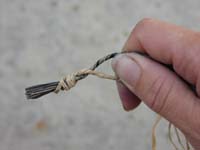
4) The energy pent up in the fibers wants to unravel, but if you hold the strands tight and remove your left hand, pulling your finger out, then that end, at the knot will twist around itself, thus using the energy to bind itself. It will only twist this way a little bit on its own. |

5) You will have to help it along to twist it tight. |
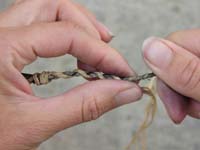
6) Next, put your left index finger between the strands again and repeat the process, gaining a quarter to half an inch with each pass... |
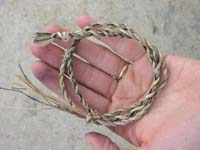
7) ...and make the cordage as long as you want. |
Making Cordage From Natural Fibers
Adapted from Participating in Nature: Wilderness Survival and Primitive Living Skills
(Scroll down the page to order dogbane stalks for making your own cordage.)
Cordage, or string, is one of those simple little things which we seldom think about but use every day and take for granted. It is only when we need a piece of cordage and do not have any that we begin to notice just how handy it is. In primitive living cordage is an integral part of many other skills. Primitive peoples used cordage for such diverse projects as fish nets and fishing line, rabbit nets, hammocks, bow and bowdrill strings, woven bags, trap strings and snares, lashing, sewing, and for just tying things up.
 Today natural fiber for cordage is produced on an industrial scale, with plantations of agave for sisal fiber in Brazil and Africa. Another agave grown in Mexico provides henequen fiber. Hemp fiber comes from nonpsychoactive varieties of the marijuana plant, grown legally outside the states. Abaca, or manila hemp is made from the leafstalk fibers of a species of banana plant, Musa textilis. The palmetto, a native of the southeastern states, produces fibers used in brushes. Jute fiber is grown in India and Bangladesh, used especially for twine and burlap. Kenaf, a hibiscus grown mainly in India, is used for canvas and cordage. Coir is a rough-textured fiber from coconut husks, often spun into a thick twine for weaving into doormats.
Today natural fiber for cordage is produced on an industrial scale, with plantations of agave for sisal fiber in Brazil and Africa. Another agave grown in Mexico provides henequen fiber. Hemp fiber comes from nonpsychoactive varieties of the marijuana plant, grown legally outside the states. Abaca, or manila hemp is made from the leafstalk fibers of a species of banana plant, Musa textilis. The palmetto, a native of the southeastern states, produces fibers used in brushes. Jute fiber is grown in India and Bangladesh, used especially for twine and burlap. Kenaf, a hibiscus grown mainly in India, is used for canvas and cordage. Coir is a rough-textured fiber from coconut husks, often spun into a thick twine for weaving into doormats.
In more primitive circumstances when you need a piece of cordage you can often improvise and use a supple willow or willow bark, or find a scrap of baling twine--or if you have a buckskin shirt, you can cut off a piece of fringe. If you do not have any of these, or if these options do not meet your needs, then you may want to make your own cordage. Across North America there are many sources of high-quality plant fibers for cordage including: dogbane, milkweed, stinging nettle, fireweed, tall evening primrose, domestic hollyhocks, flax, wild licorice, yucca, agave, sotol, cattail, bulrush, and the basswood tree. Other fibrous plants which are often used as tinder for fire starting, such as grass, sagebrush bark, juniper bark, cedar bark, or the inner bark of the cottonwood or aspen can also be used to make a weak, but thick cordage. Cordage can also be made from sinew fibers from animal tendons, plus rawhide, hair, fur, and wool. There are several different ways of preparing the cordage material, depending on the source:
Fireweed, tall evening primrose, flax, and wild licorice:
The thin, stringy bark needs to be loosened from the stalks through a process called retting, basically a mild rotting or at least a thorough soaking of the stems. Retting can occur naturally when the dead stalks are constantly wet from rain or snow. In winter the standing dead stalks are often nicely retted at the base, beneath the snow. If you can wait for your cordage, then you can do your own retting, soaking the stalks for a few days up to several weeks, to loosen the fibers. Fireweed, tall evening primrose, and wild licorice separate fairly easily from the stalks, just by peeling off the bark when properly retted. Flax fibers take a bit more work.
Several varieties of the annual flax, Linum usitatissimum are cultivated for linen fibers and linseed oil. In the wild or in flowerbeds you are more likely to encounter Linum lewisii, or another species of flax. Any species can be used for cordage, but most will have short stems with lots of little branches, and therefore shorter fibers for cordage making. The green stems can be gently scraped with a dull knife or even a fingernail to peel back the fibers, as can the retted dead stems. Start at the base and work your way up, scraping the fibers back a little bit at time into a curly mass until you reach the tip. Then straighten the fibers out to dry and discard the stems. For mass production the stalks are retted up to six weeks, then dried, beaten and scraped to remove the fibers, and finally combed to separate the waste.
Dogbane, milkweed, stinging nettle, hollyhock:
These are my favorite cordage materials. To separate the fibrous bark from the stem, start by using your fingers to flatten the stalk from one end to the other. Crush stubborn spots by biting them or by flattening them gently with a rock. Flattening the stalk splits it lengthwise into four pieces. It splits the stalk top and bottom (where your fingers were) and along the sides. By running a finger down one split you can open the stalk so you have the four lengths laid out flat. Place these across the palm of your left hand and start the next step at the butt end.
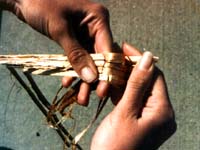 Bring your right hand down across the stalks to break them, and peel up the broken sections with your thumb as shown with dogbane in the photo, thus leaving the fibers behind. Break off no more than two inches at a time. Be careful as you pull these pieces away, as they will cling to fibers at the end and pull them out. To disconnect the fibers from the chunks of stalk, use the extra fingers on you left hand to grasp the fibers and secure them as you pull the broken pieces of stalk back in the opposite direction. Do this full step repeatedly until you have cleaned the length of the stalk. It takes some practice, but you will soon become proficient at it. Hollyhocks are processed the same way, but they require retting first, as described in the previous section. Hollyhocks are also very mucilaginous (slimy) to work with.
Bring your right hand down across the stalks to break them, and peel up the broken sections with your thumb as shown with dogbane in the photo, thus leaving the fibers behind. Break off no more than two inches at a time. Be careful as you pull these pieces away, as they will cling to fibers at the end and pull them out. To disconnect the fibers from the chunks of stalk, use the extra fingers on you left hand to grasp the fibers and secure them as you pull the broken pieces of stalk back in the opposite direction. Do this full step repeatedly until you have cleaned the length of the stalk. It takes some practice, but you will soon become proficient at it. Hollyhocks are processed the same way, but they require retting first, as described in the previous section. Hollyhocks are also very mucilaginous (slimy) to work with.
Yucca, agave, sotol:
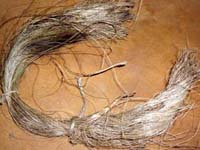 These are all members of the Agave Subfamily of the Lily Family (see Botany in a Day). All occur in the wild of the southwest, with the range of the yucca running north all the way to Montana. Each of these plants are grown domestically as well.
These are all members of the Agave Subfamily of the Lily Family (see Botany in a Day). All occur in the wild of the southwest, with the range of the yucca running north all the way to Montana. Each of these plants are grown domestically as well.
If you need cordage material right away, then look for partially rotted leaves with strong fibers intact at the base of the plants. A properly aged leaf can be beaten up with a wooden mallet on a log to help separate the fibers. You can also scrape away the green matter with the edge of a knife from a live leaf to expose the thread-like fibers. With the yucca you can leave the sharp point on the tip to serve as a natural needle.
If you have a little more time, and a source of green leaves or a whole plant (preferably one culled from a landscaping project rather than harvested wild) then you can steam pit the leaves to help break down the green matter. Read more about steam pits in the chapter on cooking. Once the leaves have been steam pitted, then it is easy to scrape away the green matter to free the good strong fibers.
Twisting Fibers into Cordage
After you have removed the fibers from the plants, take and twirl them between the palms of your hands to clean away any extra material and debris. Most types of fibers need a small amount of this type of cleaning. Then the fibers are ready to be made into cordage.
Cordage can be made any thickness and for any purpose from thread to rope. Start with a bundle of fibers roughly the thickness that you want your finished product. Tie these together at one end with a simple overhand knot. Next divide the fibers into two equal bundles and hang them on your left index finger so that the knot is on your finger and the strands hang down both sides (photo #1). For clarity in the photos, half the strands were dyed black. Hold it securely with your left hand and use your right hand to twist the fibers. Twist the fibers of one strand (photo #2) and then the other (photo #3) both in the same direction, and hold each strand securely. The energy pent up in the fibers wants to unravel, but if you hold the strands tight and remove your left hand, pulling your finger out, then that end, at the knot will twist around itself, thus using the energy to bind itself. It will only twist this way a little bit on its own (photo #4). You will have to help it along to twist it tight (photo #5). Next, put your left index finger between the strands again and repeat the process (photo #6), gaining a quarter to half an inch with each pass, and make the cordage as long as you want (photo #7).
Separating the fibers with your index finger isn't necessary, but it is easier to learn it that way. Your hands will subconsciously adapt to more efficient techniques over time.
Please note that everyone has s different system for fingering the cordage, so expect that this process will sound quite different in another book. There are many pathways to the same end.
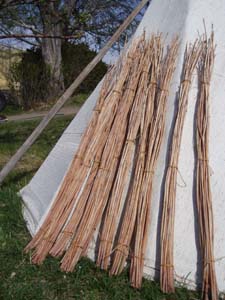 The process of making the cordage makes the fibers many times stronger than they were before. With fibers that are already strong, like dogbane, a piece of well-made cordage the size of coarse fishing line can be too strong to break by hand. To get that strength the cordage must be very uniform along its length. If one strand becomes smaller than the other then the big strand will run straight with the smaller one wrapping around it. This makes very weak cordage. To correct this problem, simply move some fibers from one strand to the other to even out the sizes, and keep cording.
The process of making the cordage makes the fibers many times stronger than they were before. With fibers that are already strong, like dogbane, a piece of well-made cordage the size of coarse fishing line can be too strong to break by hand. To get that strength the cordage must be very uniform along its length. If one strand becomes smaller than the other then the big strand will run straight with the smaller one wrapping around it. This makes very weak cordage. To correct this problem, simply move some fibers from one strand to the other to even out the sizes, and keep cording.
 When you are near the end of the fibers and you want to make a longer cord, simply lay more fibers on the others and twist them right in. It is important to stagger the splices to avoid having two joints in one spot, which weakens the cord. The cordage in the net bag shown here was spliced on a little at a time as I netted the bag. It was made of dogbane, stinging nettle and evening primrose fibers.
When you are near the end of the fibers and you want to make a longer cord, simply lay more fibers on the others and twist them right in. It is important to stagger the splices to avoid having two joints in one spot, which weakens the cord. The cordage in the net bag shown here was spliced on a little at a time as I netted the bag. It was made of dogbane, stinging nettle and evening primrose fibers.
If you need extra durability, such as for a bowdrill cord, you can make a small cord more than twice the desired length, fold it in half and cord it again. Some commercial ropes are corded that way for extra strength.
Alternately, you can work with three strands at a time by simply holding the strands over both the index finger and the middle of your left hand, and cording as you would for two strands. I notice a big difference in between 2-ply cattail cordage (i.e.: 3 strands) and 3-ply cattail cordage. The 3-ply seems a lot stronger, even when it has no more material than the 2-ply cordage.
Mastering this skill of cordage-making will help you with all your other wilderness skills, from fire-making to setting traps, making bows and arrows, and simply keeping your clothes from falling off.
Return to Granny's Country Store Home Page
|